If you’re anything like me and love road-tripping to check out new breweries, then you know that having a solid understanding of beer and different types of beer is a must.
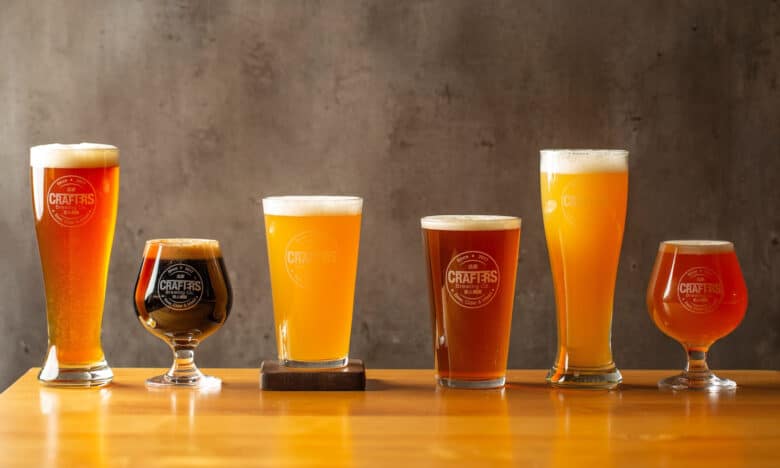
There’s a whole world of beer types (or beer styles to some) out there, which can be pretty daunting for those new to the craft beer scene.
Fear not, this article has you covered! We’re about to give you the full lowdown on all the different types of beer. Plus a few interesting facts you can share at your next kegger! Keep reading to dive head-first into the world of beer.
Lager and Ale: Two Main Beer Types
In the world of beer, there are two main categories: lagers and ales. These types of beers have different characteristics in terms of taste, appearance, and brewing process. Let’s dive into the differences between lagers and ales to understand these popular beer types better.
Lagers
- Fermentation Process: Lagers are brewed using a process called bottom fermentation. This means that the yeast sinks to the bottom of the fermentation vessel during fermentation. Lager yeast strains work best at cooler temperatures, usually between 45°F and 55°F (7°C and 13°C).
- Aging: Lagers are typically aged for longer periods than ales, sometimes for several weeks or even months. This extended aging process helps create a cleaner, smoother flavor.
- Taste: Lagers tend to have a lighter, crisper taste than ales. They are often described as clean and refreshing.
- Examples: Popular lager styles include Pilsner, Märzen, Bock, and Helles.
Ales
- Fermentation Process: Ales are brewed using a process called top-fermentation. In this method, the yeast rises to the top of the fermentation vessel during fermentation. Ale yeast strains work best at warmer temperatures, usually between 60°F and 75°F (15°C and 24°C).
- Aging: Ales typically have a shorter aging process than lagers, sometimes only requiring a few days or weeks.
- Taste: Ales tend to have a more complex, robust, and fruity taste than lagers. They can range from mildly sweet to very bitter depending on the specific style.
- Examples: Popular ale styles include Pale Ale, India Pale Ale (IPA), Stout, Porter, and Belgian-style ales.
In summary, lagers and ales are the two main beer categories, with distinct differences in their brewing processes, tastes, and aging times. Understanding these differences can help you better appreciate the various styles of beer and find the ones that best suit your taste preferences.
Key Terms of Beer Types
If you’re just getting started in the world of beer, some terms or acronyms might seem confusing. Understanding these terms can help you choose the perfect brew based on your taste and preferences. We’ll cover the key differences between two important terms, ABV and IBU, to help you become a more informed beer enthusiast.
ABV: Alcohol by Volume
- Measures the amount of alcohol in a beer
- Affects the beer’s taste, mouthfeel, and its effects on the drinker
- Range: 3% to 13% (most beers fall between 4% and 7%)
- Lower ABV: lighter, more refreshing taste
- Higher ABV: bolder, more bitter or warming taste
IBU: International Bitterness Units
- Measures the bitterness of a beer
- Affects the beer’s taste and overall flavor balance
- Range: 5 to 120 (most beers fall between 10 and 70)
- Lower IBU: less bitter, sometimes sweeter taste
- Higher IBU: more bitter, hoppy taste
By learning about ABV and IBU, you’ll be better equipped to navigate the diverse world of beer types and find the brews that match your tastes. These terms will help you make more informed decisions and enhance your beer-drinking experience. Check out the detailed sections on ABV and IBU for more in-depth information.
Top, Bottom, and Spontaneous Fermentation
In brewing, fermentation is a crucial process where yeast converts sugars into alcohol and carbon dioxide. There are three primary fermentation methods: top, bottom, and spontaneous. Each method impacts the characteristics of the final beer.
Top Fermentation
- Used primarily for brewing ales
- Yeast rises to the top of the fermentation vessel during fermentation
- Ale yeast strains work best at warmer temperatures, typically between 60°F and 75°F (15°C and 24°C)
- Results in more complex, robust, and fruity beer flavors
Bottom Fermentation
- Used primarily for brewing lagers
- Yeast sinks to the bottom of the fermentation vessel during fermentation
- Lager yeast strains work best at cooler temperatures, typically between 45°F and 55°F (7°C and 13°C)
- Results in lighter, crisper, and cleaner beer flavors
Spontaneous Fermentation
- Used for brewing certain traditional styles, like Belgian Lambic beers
- Doesn’t rely on the controlled addition of yeast; instead, relies on wild yeast and bacteria present in the air or brewing equipment
- Fermentation occurs in open vessels, exposing the beer to the environment
- Results in unique, sour, and funky flavors that can vary greatly depending on the specific microorganisms involved in fermentation
Understanding these three fermentation methods helps to appreciate the diverse range of flavors and styles found in the world of beer. Each method contributes to the unique characteristics of the final product, providing beer enthusiasts with a wide array of options to explore and enjoy.
Exploring Beer Types
Embark on a flavorful journey through the diverse world of beer! With so many styles to discover, you’ll find a brew for every taste and preference.
From the toasty and balanced Amber Beer to the bold and malty Stout, our guide introduces you to some of the most popular beer styles, providing a glimpse into the rich tapestry of flavors that awaits you. So, grab a glass and get ready to explore these amazing brews.
- Amber Beer – Toasty and balanced brew
- American Lager – Crips and refreshing classic beer
- American Pale Ale – Balanced yet hoppy brew
- Bock Beer – Rich and malty lager
- Blonde Ale – Fruity and refreshing lager
- Dunkel Beer – Smooth and malty lager
- English Pale Ale – Balanced and malty beer
- German Helles – Smooth and golden lager
- Hefeweizen – Cloudy and fruity wheat beer
- Indian Pale Ale (IPA) – Fruity and bitter ale
- Kolsch – Refreshing and hybrid beer
- Pilsner – Crisp and refreshing lager
- Porter – Dark beer with a rich flavor
- Sour – Tart and acidic beer
- Stout – Bold and malty dark beer
- Tripel – Belgian beer with high alcohol content
- Wheat Bear – Light and refreshing
Amber Beer
Amber beer is versatile and unique because it can be classified as either a lager or an ale. What sets Amber beers apart is their beautiful reddish-brown hue, which comes from the use of toasted malts.
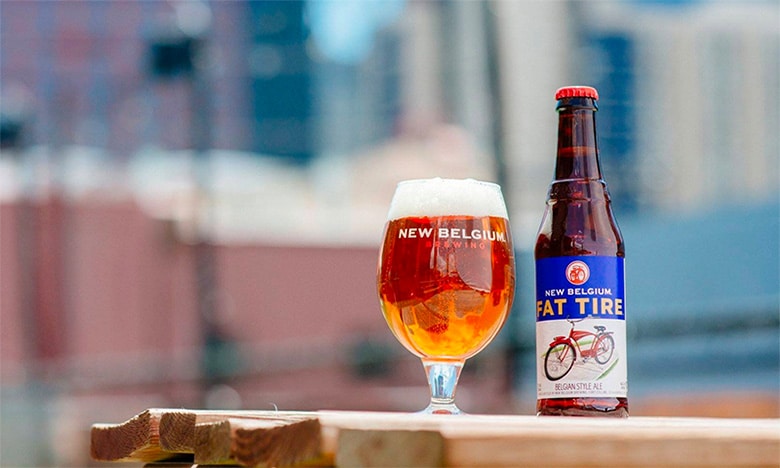
Amber Beer Features
- ABV: 4.4%-6.1%
- IBU: 18-45
- Color: gold to copper to reddish-brown
- Food Pairing: sausages, grilled veggies, and smoked pork ribs
One thing we love about Amber beer is its balanced flavor profile. It has a medium-high hop bitterness that’s perfectly balanced by the sweetness of the malt. The toasted malt flavor also gives it a touch of caramel, making it a slightly sweet and smooth beer.
Food Pairing with Amber Beer
When it comes to food pairing, Amber beer goes well with sausages, grilled veggies, and pulled pork. Its complex yet balanced flavor profile makes it a perfect pairing for these hearty and savory dishes.
Variations of Amber Beer
Some popular variations of amber beers are Vienna Lagers and American Amber Ales. Vienna lagers, are typically brewed with a combination of Vienna malt and other specialty malts, which gives them a slightly sweet, toasty flavor.
On the other hand, Amber ales are brewed with a variety of pale and caramel malts, which can result in a slightly fruitier, fuller-bodied beer with a more pronounced hop character than amber lagers.
Overall, amber lagers and amber ales are great choices for those who want a flavorful and well-balanced beer.
American Lager
American Lager is one of the most popular beer types in the United States. It’s known for its light and refreshing flavor, making it a go-to choice for many beer lovers.
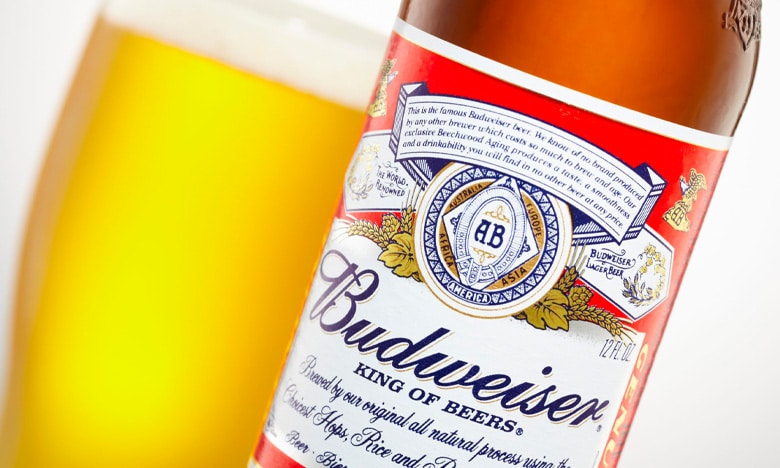
American Lager Features
- ABV: 3.2-4%
- IBU: 5-15
- Color: yellow
- Food Pairing: American cuisine, spicy food
What We Love About American Lager
One thing we love about an American Lager is its crisp and clean taste. It has a light malt-forward flavor profile, with a low bitterness and subtle hop notes. This makes it a great beer for easy drinking and pairing with a variety of foods.
Food Pairing with American Lager
American Lager pairs well with American cuisine and spicy foods. Its light and refreshing flavor profile helps to cleanse the palate and balance out the richness of the food.
Examples of American Lager
Some popular examples of American Lager include Budweiser, Coors, Miller, and Pabst Blue Ribbon. These beers are brewed to be crisp, refreshing, and easy to drink.
Overall, American Lagers are a classic beer style that are loved by many for their simplicity and drinkability. Whether you’re watching a game or enjoying a BBQ, an American Lager is a great choice for a refreshing and easy-to-drink beer.
American Pale Ale
American Pale Ale is a popular beer style among craft beer lovers. It’s known for its balance between malt and hops, making it a flavorful and refreshing beer.
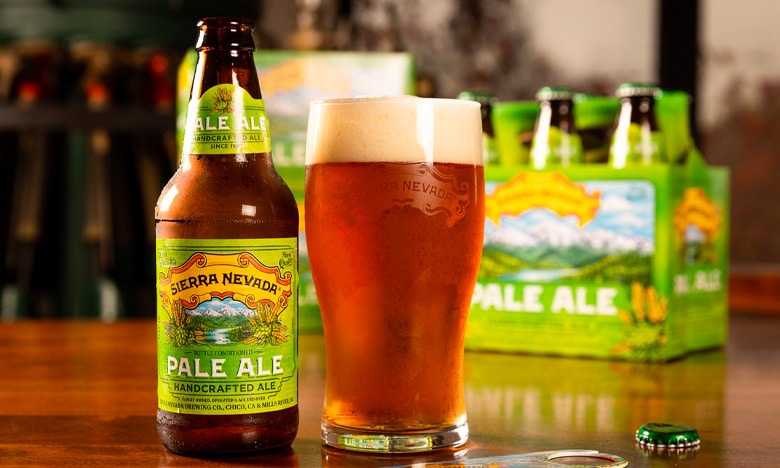
American Pale Ale Features
- ABV: 4.4%-5.4%
- IBU: 30-50
- Color: deep gold to light brown to copper
- Food Pairing: burgers, pizza, smoked buffalo wings
What We Love About American Pale Ale
One thing we love about American Pale Ales is that they’re a medium-bodied beer with a noticeable hop bitterness. They have a deep gold to light brown to copper color and a well-balanced malt and hop profile.
Food Pairing with American Pale Ale
American Pale Ale pairs well with a variety of foods, including burgers, pizza, and Buffalo chicken dip. Its hoppy and slightly bitter flavor helps cut through the food’s richness, while its malt profile provides a nice balance.
Examples of American Pale Ale
Some popular examples of American Pale Ale include Sierra Nevada Brewing Company’s Pale Ale and Smuttynose Shoals Pale Ale. These beers are brewed to be flavorful and refreshing, with a balanced malt and hop profile.
Overall, American Pale Ale is a great beer style for those who want a well-balanced and hoppy beer. Its medium-bodied texture and noticeable hop bitterness make it a flavorful and refreshing option for any occasion.
Bock Beer
Bock beer is a dark and malty lager from Einbeck, Germany. It is known for its strong and sweet flavor profile, making it a popular choice among beer lovers.
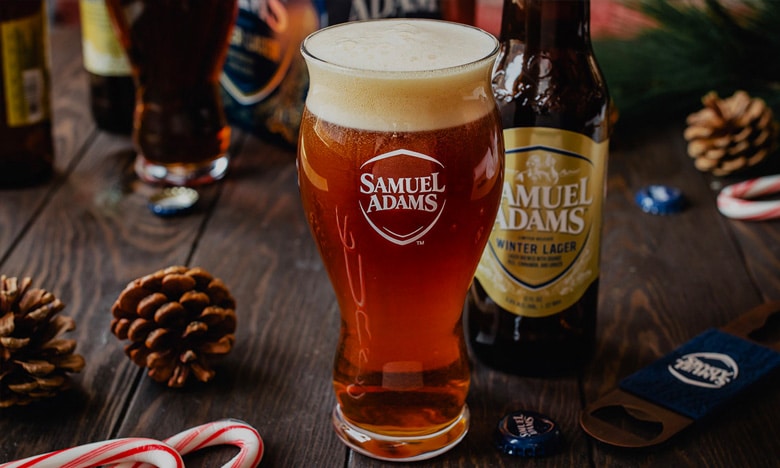
Bock Beer Features
- ABV: 6.3% – 9.5%
- IBU: 15-38
- Color: dark brown
- Food Pairing: burgers, sausages, jerk chicken
What We Love About Bock Beer
One thing we love about Bock beer is its rich and malty flavor. It has a dark brown color and a noticeable malt taste, with a subtle hop bitterness. It also has a higher alcohol content than other lager beers, making it a great option for those who want a strong and flavorful beer.
Food Pairing with Bock Beer
Bock beer pairs well with various foods, including burgers, sausages, and jerk chicken. Its rich and malty flavor profile helps to complement the savory and spicy flavors of the food.
Variations of Bock Beer
Bock beer has several variations, including maibock, doppelbock, and weizenbock. Maibock has a lighter color and more hops than traditional bock beer, while doppelbock has a higher alcohol content and a malty flavor. Weizenbock is a wheat version of bock beer that can come off just as strong as a doppelbock.
Examples of Bock Beer
Some popular examples of Bock beer include Shiner Bock, Karbach Crawford Bock, and Samuel Adams Chocolate Bock. Each of these beers has its own unique flavor profile and alcohol content.
Overall, Bock beer is a great choice for those who want a rich and malty beer with a higher alcohol content. Its unique flavor profile and variations make it a flavorful and interesting beer style to try.
Blonde Ale
Blonde Ale is a light and refreshing beer style that is perfect for those who want a flavorful and easy-to-drink beer. It has a fruity aroma and a perfect blend of malt and hops, making it a great option for any occasion.
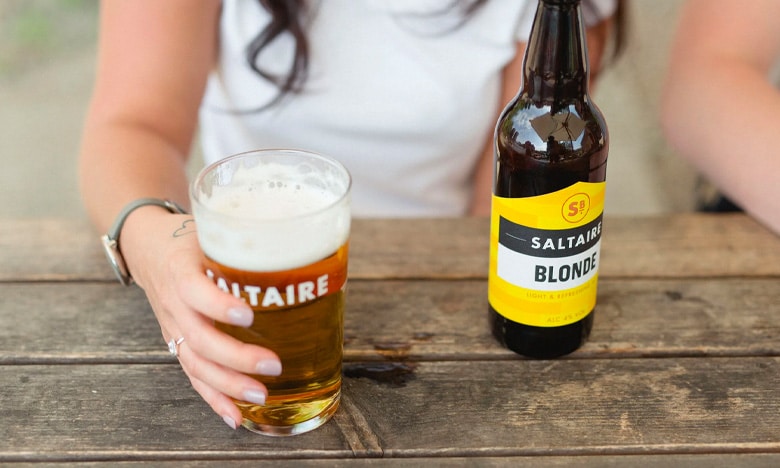
Blonde Ale Features
- ABV: 4.1% – 5.1%
- IBU: 15-25
- Color: golden yellow
- Food Pairing: Italian cuisine, spicy food, fish, pepper jack cheese
What We Love About Blonde Ale
One thing we love about a Blonde Ale is its fruity flavor profile. It has a light and refreshing taste, with a subtle hop bitterness and a fruity aroma. Its lower alcohol content also makes it a great option for those who want a flavorful beer without getting too tipsy.
Food Pairing with Blonde Ale
Blonde Ales pair well with a variety of foods, including Italian cuisine, spicy food, fish, and pepper jack cheese. Its light and refreshing flavor profile helps to complement the flavors of the food, without overpowering it.
Examples of Blonde Ale
Some popular examples of Blonde Ales include Victory Brewing Company’s Summer Love and Flying Fish Brewing Company’s Farmhouse Summer Ale. These beers are brewed to be light and refreshing, with a fruity aroma and a subtle hop bitterness.
Overall, Blonde Ale is a great choice for those who want a fruity and refreshing beer. Its lower alcohol content and versatility make it a perfect beer for any occasion.
Dunkel Beer
Dunkel Beer is a dark and malty lager from Munich, Germany. It is known for its smooth and balanced flavor profile, making it a popular choice among beer lovers.
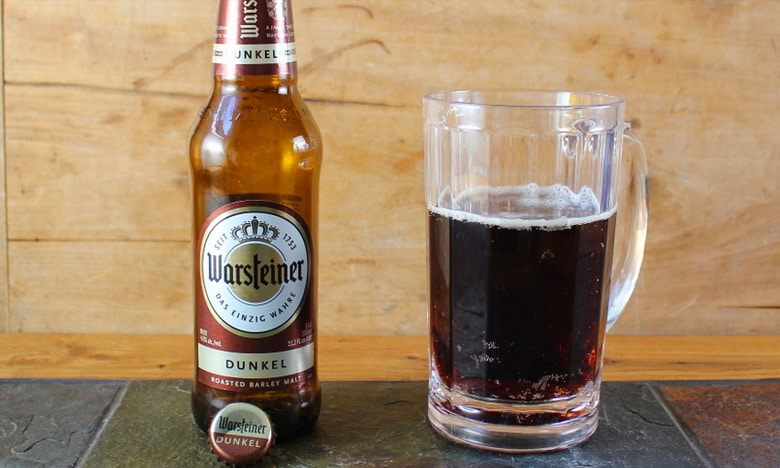
Dunkel Beer Features
- ABV: 4.8% – 5.3%
- IBU: 16-25
- Color: amber to dark reddish-brown
- Food Pairing: sausages, spicy Cajun food, chicken wings, smoked brisket
What We Love About Dunkel Beer
One thing we love about Dunkel beer is its smooth mouthfeel and strong malt flavor. It has a balanced flavor profile of chocolate, bread crust, caramel, and subtle hop bitterness. Its lower alcohol content makes it a great option for those who want a flavorful beer without getting too drunk.
Food Pairing with Dunkel Beer
Dunkel beer pairs well with various foods, including sausages, spicy Cajun food, chicken wings, and grilled meats. Its smooth and malty flavor profile helps to complement the savory and spicy flavors of the food.
Examples of Dunkel Beer
Some famous examples of Dunkel beer include Yee-Haw Dunkel and Left Hand Brewing Co. Brewer’s Test Kitchen: Dunkel. These beers are brewed to be smooth and flavorful, with a balanced malt and hop profile.
Overall, Dunkel beer is an excellent choice for those who want a smooth and malty beer with a balanced flavor profile. Its lower alcohol content and versatility make it a perfect beer for pairing with various foods.
English Pale Ale
English Pale Ale is a light and malty beer style from England. It is known for its balanced flavor profile of hop bitterness and malty sweetness, making it a popular choice among beer lovers.

English Pale Ale Features
- ABV: 4.5% – 5.5%
- IBU: 20-40
- Color: golden brown
- Food Pairing: American and English cuisines meat, English cheese, smoked chicken breast, maple bread pudding
What We Love About English Pale Ale
One thing we love about English Pale Ale is its balanced flavor profile of hop bitterness and malty sweetness. It has a medium-bodied texture with some caramel flavors, making it a great option for those who want a flavorful and easy-to-drink beer.
Food Pairing with English Pale Ale
English Pale Ale pairs well with a variety roasted flavors of foods, including American and English cuisines, various meats, English cheese, roasted chicken, and maple bread pudding. Its balanced flavor profile helps to complement the savory and sweet flavors of the food.
Examples of English Pale Ale
Some popular examples of English Pale Ale include Black Sheep Ale and Flying Fish Extra Pale Ales. These beers are brewed to be light and malty, with a balanced hop and malt profile.
Overall, English Pale Ale is a great choice for those who want a balanced and malty beer with a medium-bodied texture. Its versatility and flavor profile make it a perfect beer for pairing with a variety of foods.
German Helles
German Helles is a light and smooth lager beer that originated from Germany. It is known for its balanced flavor profile of malt sweetness and low hop bitterness, making it a popular summer beer of choice among beer lovers.
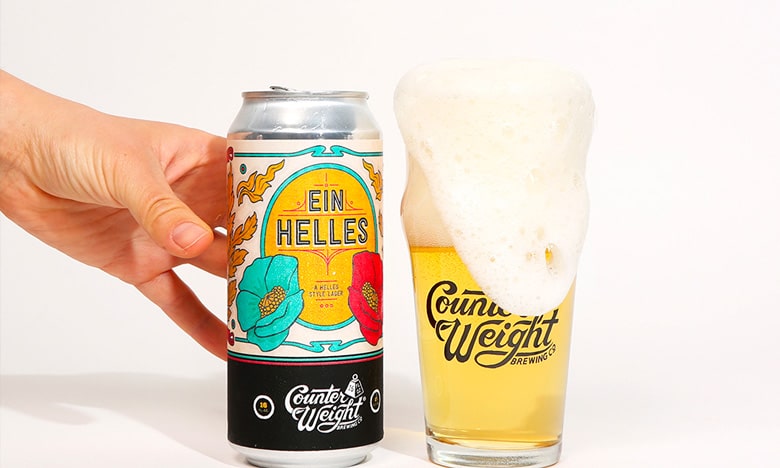
German Helles Features
- ABV: 4.8% – 5.6%
- IBU: 18-25
- Color: light to golden yellow
- Food Pairing: samosas, colby, baklava, pork, brie cheese
What We Love About German Helles
One thing we love about German Helles is its smooth and balanced flavor profile. It has a noticeable malt flavor with hints of roasted barley, but with low hoppy bitterness. Its carbonation level is medium to high, giving it a distinct appearance of medium and fast-rising bubbles.
Food Pairing with German Helles
German Helles pairs well with a variety of foods, including samosas, colby, baklava, pork, and brie cheese. Its balanced flavor profile helps to complement the sweet and savory flavors of the food.
Examples of German Helles
Some popular examples of German Helles include Dry Dock Brewing Co. Helles, Victory Brewing Co. Helles Lager, and The Austin Beer Garden Brewing Co. Hell Yes. These beers are brewed to be light and smooth, with a balanced malt and hop profile.
Overall, German Helles is a great choice for those wanting a light, smooth beer with a balanced flavor profile. Its versatility and carbonation level make it a perfect beer for pairing with a variety of foods.
Hefeweizen
Hefeweizen is a German-style wheat beer that is known for its cloudy appearance and fruity flavor profile. It is a perfect beer for those who want a mild and refreshing light beer without the bitterness.
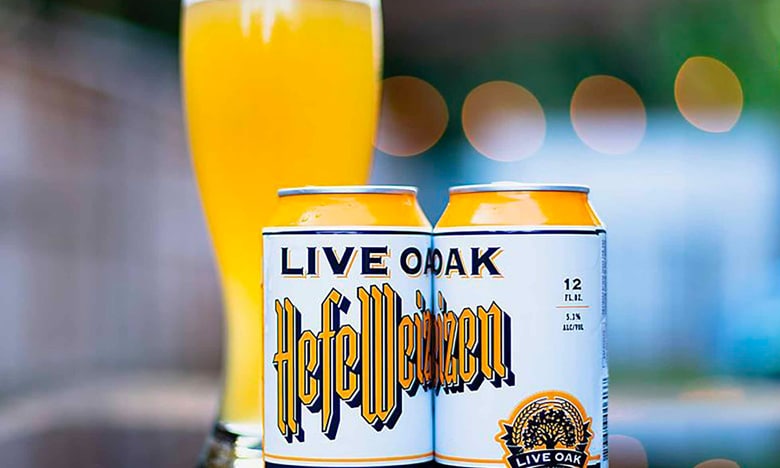
Hefeweizen Beer Features
- ABV: 4.9% – 5.6%
- IBU: 10-15
- Color: straw to amber
- Food Pairing: seafood, chevre, key lime pie
What We Love About Hefeweizen
One thing we love about Hefeweizen is its fruity flavor profile with banana and clove notes. It has a cloudy appearance due to its high wheat and yeast content, making it a unique beer style. It has a mild alcohol content with low hop bitterness, making it a perfect beer for those who want a light and refreshing beer.
Food Pairing with Hefeweizen
Hefeweizen pairs well with a variety of foods, including seafood, chevre, and key lime pie. Its fruity and refreshing flavor helps to complement the savory and sweet flavors of the food.
Examples of Hefeweizen
Some popular examples of Hefeweizen include Dreamweaver Wheat from Troegs Brewing Co., Big Horn Hefeweizen from CB, and Potts Restaurant & Brewery. These beers are brewed to be fruity and refreshing, with a mild alcohol content and low hop bitterness.
Overall, Hefeweizen is a great choice for those who want a light, refreshing beer with a unique fruity flavor. Its cloudiness and mild alcohol content make it a perfect beer for pairing with various foods.
India Pale Ale (IPA)
IPA or India Pale Ale is a beer style known for its high alcohol content, fruity flavor, and strong hop bitterness. It is a popular beer style among craft beer lovers who enjoy bold and complex beer.
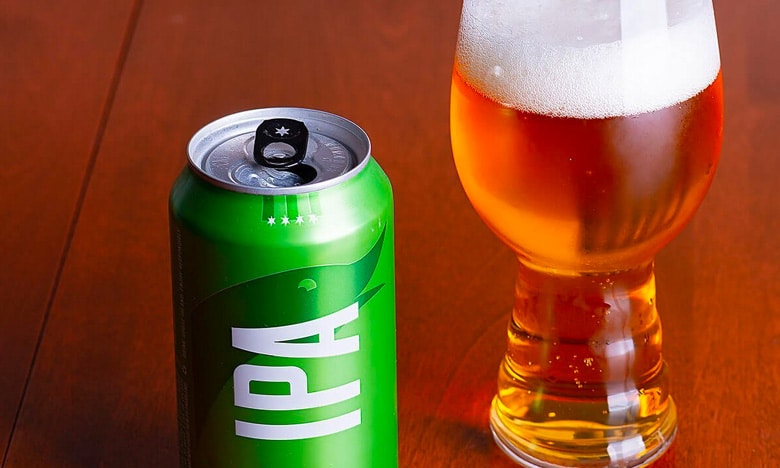
India Pale Ale (IPA) Features
- ABV: 5.1% – 10.6%
- IBU: 50-70
- Color: light gold to coppery brown
- Food Pairing: spicy sausages, french fries, fish tacos, rich cheeses
What We Love About IPA
We love IPAs because of their piney and floral flavors and strong hop bitterness. This beer style also has a hazy appearance, adding to its appeal. IPAs also have a fruity taste that helps balance out the hops’ strong bitterness. IPAs typically come in three different variations; American IPA, Imperial or Double IPA, and English IPA.
Types of IPA
The American IPA has a higher bitterness than an ordinary pale ale, with an IBU of 50-70 and ABV of 6.3% – 7.5%. It has citrus flavors and is similar to the English style.
The Imperial or Double IPA has a higher ABV at 7.0% – 14.0%, making it one of the strongest beer types. It has a strong flavor and hop bitterness at IBU 65-100.
Lastly, the English IPA has a generally lower ABV at 5.0%-7.0% and a lower IBU of 35-63. It tastes similar to the American style but doesn’t taste as bitter due to its lower IBU.
Food Pairing with IPA
IPA pairs well with spicy sausages, french fries, fish tacos, and rich cheeses. Its fruity and hoppy flavors complement the savory and spicy flavors of the food.
Examples of IPA
Some popular examples of IPA are Bell’s Two Hearted Ale, New Belgium Voodoo Ranger Imperial IPA, and Goose Island IPA. These beers are brewed to be fruity, bitter, and complex, making them a favorite among craft beer lovers.
Kolsch
Kolsch is a unique beer style that is a hybrid of an ale and a lager. It has a light and refreshing taste, making it a perfect drink for those who want a break from the heavy and complex beers.

Kolsch Beer Features
- ABV: 4.4% – 5.2%
- IBU: 20-30
- Color: light gold
- Food Pairing: grilled chicken, sushi, nutty cheeses
What We Love About Kolsch
We love Kolsch because of its light and slightly dry mouthfeel with a soft sweetness to it. It has a low IBU of 20-30, making it perfect for those who prefer a mild hop bitterness. You may also taste hints of apple or light pear, adding to its refreshing and crisp taste.
Food Pairing with Kolsch
Kolsch pairs well with grilled chicken, sushi, and nutty cheeses. Its light and refreshing taste complements the savory flavors of the food, making it a perfect drink for a summer barbecue or picnic.
Examples of Kolsch
Some popular examples of Kolsch are Altstadt Kolsch, Yee Haw Kolsch, and Rogue Honey Kolsch. These beers are brewed to be light and refreshing, making them a perfect drink for any occasion.
Pilsner
Pilsner is a famous beer style that originated from Plzen, Czech Republic. It’s known for its high hoppy bitterness that sweeter malts can temper. Pilsners have an IBU that can reach up to 50, making it a popular choice among beer enthusiasts.
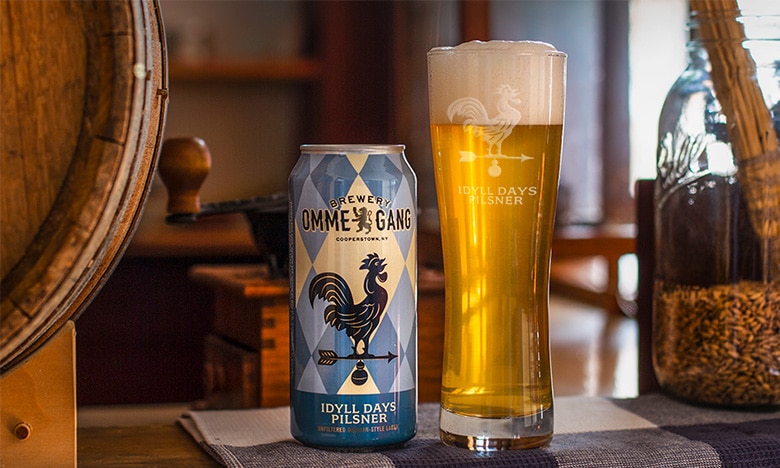
Pilsner Features
- ABV: 4.1% – 5.3%
- IBU: 25-50
- Color: straw to pale gold to light amber
- Food Pairing: ramen, tacos, spicy chili, white cheddar, chicken, salads
What We Love About Pilsner
We love Pilsners because of their crisp and refreshing taste. They’re truly the perfect drink to beat the summer heat! Their fruity taste and aroma levels are low, unless you have a trained taste or palate.
A Pilsner has a soft body with a short finish, like other pale lagers. It also has a refreshing mouthfeel that makes it a pleasant drink.
Food Pairing with Pilsner
Pilsners pair well with ramen, tacos, spicy chili, white cheddar, chicken, and salads. Its crisp and refreshing taste complement the savory and spicy flavors of these foods.
Examples of Pilsner
Some popular examples of Pilsner are Firestone Walker Brewing Co.’s Pivo Pils, Snake River Brewing Co.’s Paintbrush Pilsner, and Victory Brewing Co.’s Prima Pils. These beers are crafted to be crisp and refreshing, making them popular among beer enthusiasts.
Porter
Porter is one of the darker beers that originated from England and was once known as the drink of choice for street and river porters. With a dark brown color resembling cola, Porters have a rich flavor that is favored by many beer enthusiasts.

Porter Features
- ABV: 4.4% – 6%
- IBU: 20-30
- Color: dark brown
- Food Pairing: brownies, ribs, smoked gouda, enchiladas
What We Love About Porter
We love Porters because of their rich and complex flavor. This beer style has a roasted malt taste balanced with medium hop bitterness. Porter’s dark brown color and creamy texture also adds to its appeal.
Types of Porter
There are five variations of Porter, including American Imperial Porter, Baltic-Style Porter, English Style Brown Porter, Robust Porter, and Smoke Porter. Each variation has its unique flavor and characteristics.
Food Pairing with Porter
Porter pairs well with brownies, ribs, smoked gouda, and enchiladas. Its rich and complex flavor complements the savory and spicy flavors of the food.
Examples of Porter
Some popular examples of Porter are Shipyard Brewing Co.’s Imperial Porter, Twisted Pine Brewing Co.’s Northstar Imperial Porter, and Breckenridge Vanilla Porter. These dark beers are brewed to be rich, flavorful, and complex, making them a favorite among beer enthusiasts.
Sour
Sour beer can vary widely in terms of alcohol content, IBU, and color, but one thing remains consistent – its tart and acidic taste. If you enjoy sour flavors, then this beer is definitely for you.
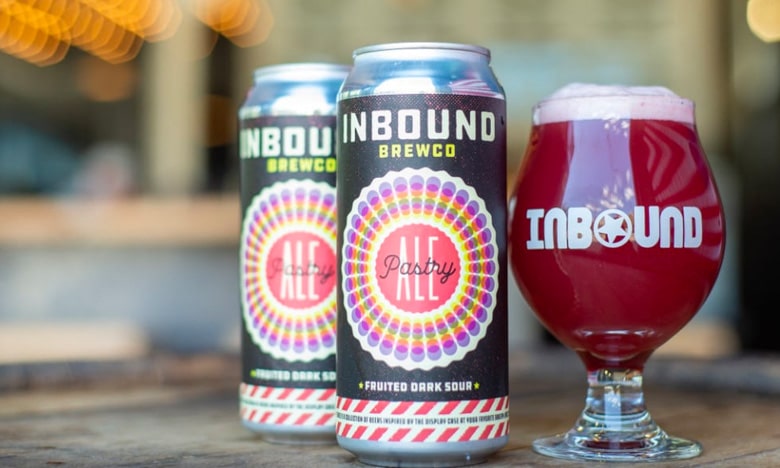
Sour Beer Features
- ABV: wide range
- IBU: wide range
- Color: wide range
- Food Pairing: tangy cheeses, cured meat
What We Love About Sour Beer
We love sour beer because of its unique tart and acidic flavor. It is a perfect drink for those who want to try something new and different from the usual beer types. Some sour beers also have fruity flavors that complement the sour taste of fruit beers.
Types of Sour Beer
There are many types of sour beer, including American Sours, Belgian-style Sour Ales, and Lambics. Each type has its unique flavor and characteristics that make them distinct from one another.
Food Pairing with Sour Beer
Sour beer pairs well with the tangy flavors and cheeses and cured meats. Its tart and acidic taste complements the savory and salty flavors of the food.
Examples of Sour Beer
Some popular examples of sour beer are Queen of Tarts from Karl Strauss Brewing Co., Le Petit Prince from Jester King Brewery, and Ching Ching from Bend Brewing Co. These sour beers are brewed to have a tart and acidic flavor, making them a favorite among sour beer enthusiasts.
Stout
Stout is a type of beer known for its bold and malty flavor. It has a dark brown to black color and a high hop bitterness. Stouts are popular among craft beer enthusiasts who enjoy a rich and complex beer.

Stout Features
- ABV: 3.2% – 12%
- IBU: 15-80
- Color: dark brown to black
- Food Pairing: pad Thai, ice cream, meat
What We Love About Stout
We love Stouts because of its rich and complex flavor. It has a roasted malt taste balanced with high hop bitterness. Stouts have a dark color and creamy texture, adding to its appeal.
Types of Stout
There are five variations of Stout, including American Imperial Stout, American Stout, English-Style Oatmeal Stout, English-Style Sweet Stout or Milk Stout, and Irish-Style Dry Stout. Each variation has its unique flavor and characteristics.
Food Pairing with Stout
Stouts pair well with pad Thai, ice cream, and meat. Its bold and malty flavor complements the savory and sweet flavors of the food.
Examples of Stout
Some popular examples of Stouts are Deschutes Obsidian Stout, Guinness Draught, and Vault Breakfast Stout. These beers are brewed to be bold, malty, and complex, making them a favorite among craft beer enthusiasts.
Tripel
Tripel is a Belgian beer known for its high alcohol content and unique flavor profile. It has a pale-to-pale gold color and slight hop bitterness. Tripel is a popular beer style among those who enjoy bold and complex beer.

Tripel Features
- ABV: 7.1-10.1%
- IBU: 20-45
- Color: pale to pale gold
- Food Pairing: pasta, meat, poultry
What We Love About Tripel
We love Tripel because of its unique and complex flavor. It has a slightly spicy taste with noticeable sweet flavors. Tripel has a light body for a spice beer and a high alcohol content, making it a favorite among beer enthusiasts who want a bold and flavorful beer.
Types of Tripel
Technically, there is only one type of Tripel, which is a Belgian beer. However, each brewery has its unique recipe and brewing process, which gives their Tripels distinct flavor and unique characteristics.
Food Pairing with Tripel
Tripel pairs well with pasta, meat, and poultry. Its unique sour flavor complements the savory and spicy flavors of the food.
Examples of Tripel
Some popular examples of Tripel are Allagash Tripel from Allagash Brewing Co., Tripel from Green Flash Brewing Co., and PDA from Black Bottle Brewery. These beers are brewed to be bold, complex, and flavorful, making them a favorite among beer enthusiasts.
Wheat Beer
Wheat beer is a type of beer that is known for its light body and refreshing taste. It has a straw to light amber color and a low to medium hop bitterness. Wheat beer is popular among craft beer enthusiasts who enjoy light and fruity beer.

Wheat Beer Features
- ABV: 2.8% – 5.6%
- IBU: 10-35
- Color: straw to light amber
- Food Pairing: burritos, salads, fruit desserts
What We Love About Wheat Beer
We love Wheat beer because of its light and refreshing taste. It has a fruity and aromatic flavor that is unique to this type of beer. Wheat beer is also usually served unfiltered, which adds to its appeal.
Types of Wheat Beer
There are several styles of wheat beer, including Belgian Witbier, German Weizen, and American Wheat Beer. Each type has its unique flavor and characteristics.
Food Pairing with Wheat Beer
Wheat beer pairs well with burritos, salads, and fruit desserts. Its light and fruity flavor complements the spicy and sweet flavors of the food.
Examples of Wheat Beer
Some popular examples of wheat beer are Telluride Brewing Co.’s Whacked Out Wheat, Bell’s Brewery Inc.’s Oberon, and Altitude Chophouse and Brewery’s Tumblewheat. These wheat beers are brewed to be light, refreshing, and fruity, making them a favorite among craft beer enthusiasts.
ABV Explained
Beer ABV, short for alcohol by volume, tells you how much alcohol is in a beer. It’s important because it affects the beer’s taste, feel in your mouth, and how it makes you feel when you drink it. Let’s learn about ABV, how it changes different kinds of beer, and the brewing process.
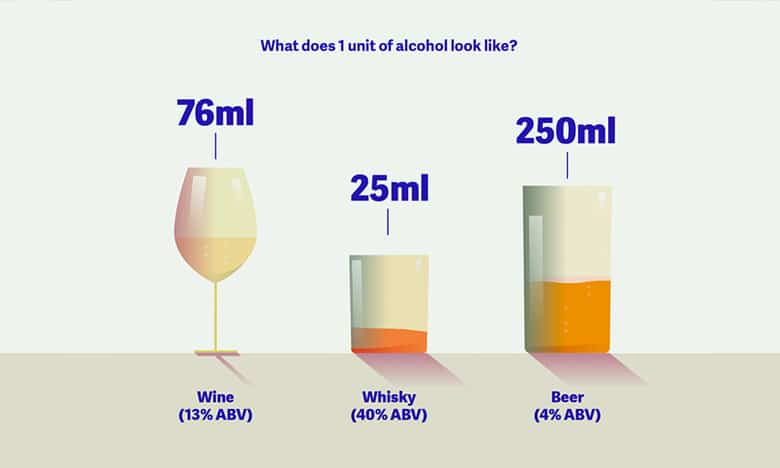
ABV Range in Beers: Beer usually has an ABV between 3% and 13%. Most beers are in the 4% to 7% range. Light beers have a lower alcohol content, around 3% to 4%. Strong beers can have an ABV of 8% or more.
What Changes ABV: How a beer is made and the ingredients used can change its ABV. When making beer, the yeast eats sugar, creating alcohol and bubbles. The amount of sugar and the kind of yeast used can change the final ABV. Beers with more alcohol usually have more sugar and a type of yeast that can handle more alcohol.
How ABV Affects Taste: The amount of alcohol in a beer changes how it tastes. Beers with more alcohol can taste bitter or warm. Beers with less alcohol are often lighter and more refreshing. The ABV can also change how the beer feels in your mouth. Beers with more alcohol can feel richer or heavier.
Balancing ABV in Brewing: When making beer, brewers think about ABV to ensure the beer has the right balance of sweet and bitter flavors. Different types of beer have different target ABV ranges. For example, a light lager might have a lower ABV to make it crisp and refreshing, while a strong imperial stout might have a higher ABV for bold, complex flavors.
Understanding beer ABV can help you enjoy different beers and learn more about how they are made. Knowing how ABV affects the taste and feel of a beer can improve your drinking experience and help you choose the right beer for you.
Understanding IBU
Beer IBU, short for International Bitterness Units, is a scale that measures the bitterness of a beer. It’s essential because it affects the beer’s taste and helps you understand the beer’s overall flavor profile. Let’s learn about IBU and how it influences different kinds of beers and the brewing process.
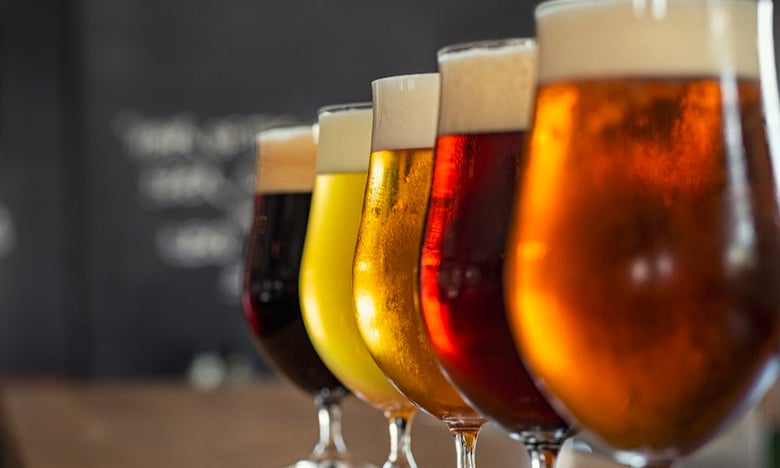
IBU Range in Beers: Beer usually has an IBU ranging from 5 to 120. Most beers fall between 10 and 70 IBUs. Lighter beers, like lagers and pilsners, have a lower IBU, around 10 to 35. Bolder, hoppy beers, like IPAs, can have an IBU of 40 to 120 or more.
What Changes IBU: The bitterness in a beer mainly comes from hops, which are flowers added during the brewing process. Different kinds of hops and the amount used can change a beer’s IBU. The way hops are added to the beer, and the length of time they are boiled can also affect the final IBU.
How IBU Affects Taste: The IBU of a beer changes how it tastes. Beers with a higher IBU will have a more bitter taste, while beers with a lower IBU will be less bitter and sometimes sweeter. The IBU can help you understand the balance of flavors in a beer, like how sweet or bitter it might be.
Balancing IBU in Brewing: Brewers think about IBU to create the right balance of flavors. Different types of beer have different target IBU ranges. For example, a light lager might have a lower IBU to make it crisp and easy to drink, while a hoppy IPA might have a higher IBU for a bold, bitter taste.
Understanding beer IBU can help you enjoy different beers and learn more about how they are made. Knowing how IBU affects a beer’s taste can improve your drinking experience and help you choose the right beer for your taste preferences.
For a detailed IBU chart.
Beer Types FAQs
The two main types of beer are lager and ale. Lagers are brewed with bottom-fermenting yeast at cooler temperatures, while ales are brewed with top-fermenting yeast at warmer temperatures.
The primary difference between a lager and an ale is the fermentation process. Lagers are brewed with bottom-fermenting yeast at cooler temperatures (35˚F – 50˚F), while ales use top-fermenting yeast and ferment at warmer temperatures (60˚F – 70˚F).
ABV stands for alcohol by volume, which represents the alcohol content in the beverage. It is expressed as a percentage, with most beers having an ABV ranging from 4% to 7%.
IBU, or international bitterness unit, measures the number of bitter flavor compounds in a beer. It helps indicate how bitter a beer is, with a range that starts at 0 and goes above 100.
Some examples of top-fermenting beer types include India Pale Ales (IPAs), stouts, and wheat beers. These beers are brewed using a top-fermenting yeast at warmer temperatures.
Some examples of bottom-fermenting beer types are Pilsners, Bocks, and Oktoberfests. These beers are brewed using bottom-fermenting yeast at cooler temperatures.
Some popular beer styles include India Pale Ale (IPA), Stout, Porter, Pilsner, Belgian Dubbel, and Hefeweizen. These styles showcase the diverse range of flavors and characteristics found in the world of beer.
Stouts and porters are both dark, full-bodied beers. The main difference between the two is the type of malt used during brewing. Stouts typically use unmalted roasted barley, which imparts a coffee-like flavor, while porters use malted barley, resulting in a sweeter and more chocolatey taste.
Sour beers are a category of beers characterized by their intentionally tart, sour, or acidic flavors. They are typically brewed using wild yeast strains or bacteria, such as Lactobacillus or Brettanomyces, and can be aged in barrels for added complexity.
A session beer is a type of beer that is lower in alcohol content, typically with an ABV of around 5% or less, and has a balanced flavor profile. The term “session” refers to the idea that one can enjoy multiple beers during a drinking session without becoming overly intoxicated.
A double IPA, or DIPA, is a stronger and hoppier version of a standard India Pale Ale (IPA). DIPAs typically have a higher alcohol content, usually ranging from 7.5% to 10% ABV, and feature more intense hop flavors and aromas.
Wheat beer, also known as Weissbier or Hefeweizen, is a type of beer brewed with a significant amount of wheat in addition to barley malt. Wheat beers tend to have a lighter color, hazy appearance, and a distinctively smooth, fruity, and sometimes spicy flavor profile.